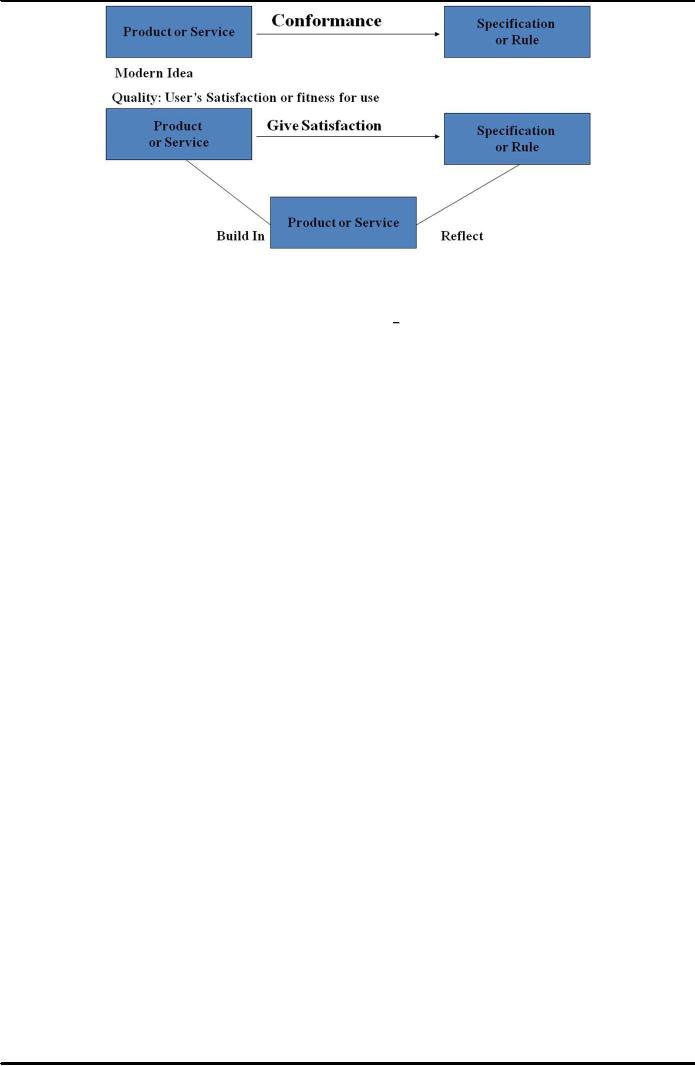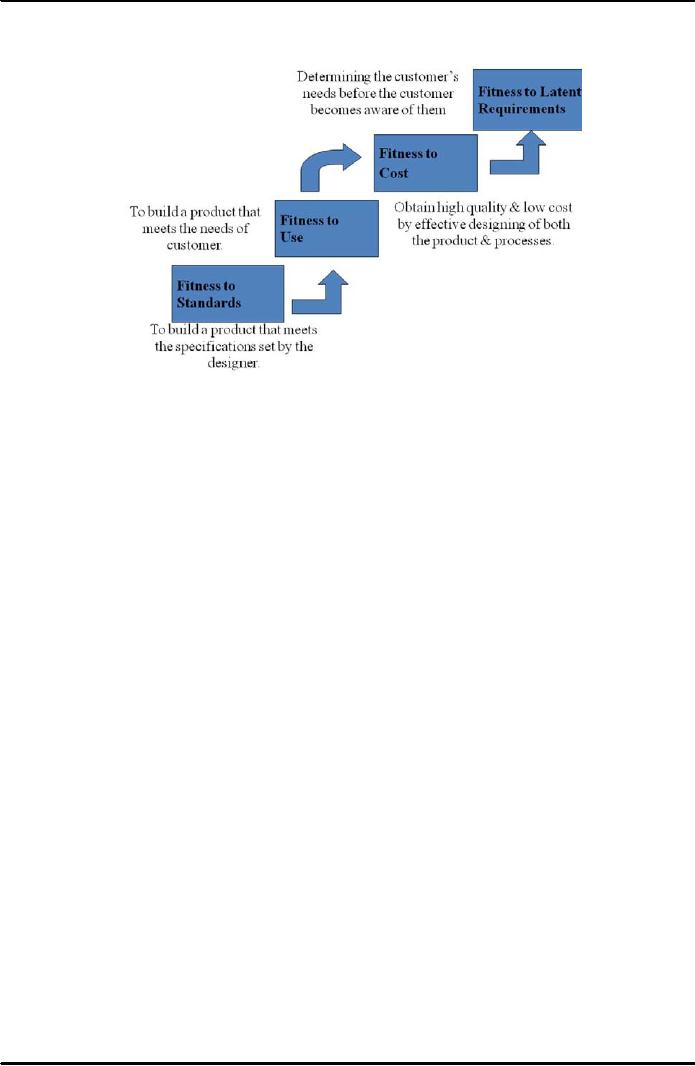 |

Project
Management MGMT627
VU
LESSON
34
QUALITY
IN PROJECT MANAGEMENT
BROAD
CONTENTS
What
is Quality?
Quality
from Different Perspective
Quality
Dimensions
Competitive
Advantage
Quality
Evolution and Quality Stages in Japan
TQM
(Total Quality Management) and Its Philosophy
34.1
WHAT
IS QUALITY?
Quality
is by no menus a new concept in modern
business. In October 1887, William
Cooper
Procter,
grandson of the founder of Procter
and Gamble, told his employees,
"The first job we
have
is to him out quality
merchandise that consumers
will buy and keep on buying.
If we
produce
it efficiently and economically, we
will earn a profit, in which
you will share."
Procter's
statement
addresses three issues t h a t
are critical to managers of
manufacturing and
service
organizations:
p r o d u c t i v i t y , cost, and
quality. Productivity (the measure of
efficiency defined as
the
amount of output achieved per
unit of input), the cost of
operations, and the quality of
the
goods
and services t h a t create
customer sa t is fa c ti o n all
contribute to profitability. Of these
three
determinants
of p r o f i t a b i li t y , t h e most s i g n i f i c a n t
factor in d e t e r m i n i n g the
long-run
success
or f a i l u r e of any organization is q u a l i t y
. High q u a l i t y goods and
services can
provide
an o r g a n i z a t i o n w i t h a c o m p e t i t i v e edge.
High q u a l i t y reduces costs due
to
returns,
rework, and scrap. It increases p r o d u
c t i v i t y , p r o f i t s , a n d o t h e r measures
of
success.
Most i m p o r t a n t l y , h ig h q u a l i t y
generates s a t i s f i e d customers,
who reward the
organ
i z a t i o n w i t h c o n t i n u e d patronage and
word-of-mouth advertising.
Quality
can be a confusing concept, p a r t l y
because people view q u a l i t y in
relation to
d
i f f e r i n g criteria based on their i
n d i v i d u a l roles in the
production-marketing value
chain.
In addition, the meaning of q u a l i t y continues to
evolve as the quality profession
grows
and matures. Neither
consultants nor business professionals
agree on a universal
definition.
A study t h a t asked managers of 86 f i r m s in
the eastern United States to
define
q
u a l i t y produced several dozen
different responses, including
the following:
1.
Perfection
2.
Consistency
3.
Eliminating
waste
4.
Speed
of delivery
5.
Compliance
w i t h policies and
procedures
6.
Providing
a good, usable
product
7.
Doing
it right the first
time
8.
Delighting
or pleasing customers
9.
Total
customer service and
satisfaction
Thus,
it is important to understand the
various perspectives from
which q u a l i t y is
viewed
in order to f u l l y appreciate the
role it plays in the many p
a i l s of a business
organization.
The
concept of quality is subjective and difficult to define. While certain aspects
of quality can
be
identified, ultimately, the "judgement of quality" rests with the
customer.
248

Project
Management MGMT627
VU
Figure
34.1
QUALITY
FROM DIFFERENT PERSPECTIVES:
34.2
�
J
u d g m e n t a l Perspective:
One
common notion of q u a l i t y, used by
consumers, is t h a t it is synonymous wit h
superiority
or excellence. In 1931 Walter
Shewhart f i r s t defined q u a l i t y as t h e
goodness
of
a product. This v i e w is referred to as
the transcended
(to
rise above or extend notably
beyond
ordinary lim its),
d
e f i n i t i o n of quality. In this
sense, q u a l it y is "both
absolute
and
u n i v e r s a l l y recognizable, a mark of
uncompromising standards and
high
achievem
e n t." As such, it cannot he defined
precisely--you j u s t know it when
you see
i
t . It is o f t e n loosely related to a
comparison of f e a t u r e s and
characteristics of products
and
promulgated by m a r k e t i n g e f f o r t s aimed at
developing q u a l i t y as an
image
v
a r i a b l e in the minds of consumers.
Common examples of products a t t r i b uted w i t
h
t
h i s image are Kolex
watches and BMW and Lexus
automobiles.
�
Product-Based
Perspective:
Another
definition of q u a l i t y is t h a t it is a f u n c t i o n of a
specific, measurable variable
and
t
h a t differences in q u a l i t y reflect
differences in q u a n t i t y of product a t t r i b
u t e , such as
in
the number of stitches per i n c h on a s h i r t or in the number
of cy linders in an engine.
This
assessment i m p l i e s t h a t higher
levels or amounts of product
characteristics are
equivalent
to higher quality, As a result,
quality is o f t en mistakenly assumed to
be
related
to price: t h e higher t h e price, the
higher the quality. J u s t consider t h
e case of a
F
l o r i d a man who purchased a
$262,000 Lamborghini o n l y to find a
leaky roof, a b a t t e r y
t
h a t q u i t w i t h o u t notice, a sunroof t h a t
detached when the car
hit a bump, and doors t h a
t
jammed
" However, a product refer to
either a m a n u f a c t u r e d good or a
service--need not
be
expensive to be considered a q u a l i t y product by
consumers. Also, as w i t h t he n o t io n
of
excellence,
the assessment of product a t t r i b u t e s
may v a r y considerably among
individuals.
�
User-Based
Perspective:
A
third definition of q u a l i t y is
based on the presumption t h a t q u a l
i t y is determined by
what
a customer wants. I n d i v i d u a l s
have d i f f e r e n t wants and
needs and, hence, d i f
ferent
quality
standards, which leads to a user-based
definition: q u a l i t y is defined a s f i t n e s s f o
r
intended
use, or
how well t h e product
performs its intended
function. Both a
Cadillac
sedan
and a Jeep Cherokee arc f i t
for use, for example, but
they serve different needs
and
d
i f f e r e n t groups of customers. If
you want a highway-touring
vehicle w i t h lu xu r y
amenities,
then a C a di ll a c may b e t t e r s a t i s f y
your needs. If you want a
vehicle for
camping,
fishing, or skiing trips, a
Jeep might be viewed as h a v i n g
better quality.
249

Project
Management MGMT627
VU
�
Value-Based
Perspective:
A
fourth approach to d e f i n i n g q u a l i t y is
based on value;
t
h a t is, the relationship of
usefulness
or satisfaction to price. From
this perspective, a q u a l i t y product is one
that is
as
useful as competing products
and is sold at a lower
price, or one that offers
greater
usefulness
or s a t i s f a c t i o n at a comparable p r i c e .
Thus, one might purchase a
generic
product,
rather t h a n a brand name
one, if it performs as well as
the brand-name
product
at a lower price. An example of t h i s
perspective in practice is evident in
a
comparison
of t h e U.S. and Japanese a u t o m o b
i l e markets. A Chrysler
marketing
executive
noted "one of t h e main
reasons t h a t t h e l o a d i n g Japanese
brands--Toyota
and
Honda--don't offer t h e huge
incentives of t h e big Three
(General Motors,
Ford,
and
Chrysler) is t h a t they have a
much better reput ation
for long-term durability."
In
essence,
incentives and rebates are payments to
customers lo compensate for
lower
quality.
�
Manufacturing-Based
Perspective:
A
f i f t h view of q u a l i t y is manufacturing-based and d e f i n e s q u a l
i t y as the desirable
outcome
of engineering and m a n u f a c t u r i n g practice,
or conformance
to specifications.
S
p e c i f i c a t i o n s are t a r g e t s and
tolerances determined by designers of
products and
services.
Targets are t h e ideal
values for w hi c h production is to
strive; tolerances
are
specified
because designer's recognize t h a t it
is impossible to meet targets a l l of
the
t
i m e in manufacturing. For example, a
part dimension might be
specified as "0.236 i
0.003
cm." These measurements would mean t h a t t h e t a r
g e t , or ideal value, is
0.236
centimeters,
and t h a t the allowable v a r i a t i o
n is (MHB centimeters from the target
(a
tolerance
of 0.006 cm.). Thus, any
dimension in t h e range 0.233 to
0.239 centimeters is
deemed
acceptable and is said to
conform lo s p e c i f i c a t i o n s . Likewise, in
services,
"on-time
a r r i v a l " for an a i r p l a n e might be
specified as w i t h i n ' 15 minutes of th
e
scheduled
a r r i v a l time. The target is
the scheduled time, and the
tolerance is specified
to
be 15 minutes.
�
Integrating
Perspectives on Quality:
Although
product q u a l i t y should be important
to a ll i n d i v i d u a l s throughout the
value
chain,
how q u a l i t y is viewed may depend on
one's p o s itio n in the v a l u e
chain, that is,
whether
one is t h e designer, manufacturer or s
erv i ce provider, distributor,
or
customer.
The customer is the driving
force for the production of
goods and services,
and
customers generally v i e w quality from
either the transcendent or
the product-
based
perspective. The goods and
services produced should
meet customers'
needs;
indeed,
business organizations' existences depend
upon meeting customer needs. It
is
the
rule of the marketing
function to determine these needs. A
product that meets
customer
needs can rightly be described as a
quality product. Hence, the
user-based
definition
of quality is meaningful to people
who work in
marketing.
The
manufacturer must t r a n s l a t e
customer requirements into
detailed product and
process
specifications. Making this
translation is the role of research
and devel-
opment,
product design, and
engineering. Product specifications
might address such
attributes
as size, form, finish, t as t e ,
dimensions, tolerances, materials,
operational
characteristics,
and s a f e t y featu res .
Process specifications indicate
the types of
equipment,
tools, and facilities to be
used in production. Product
designers must
balance
performance and cost to meet
marketing objectives; thus,
the value-based
definition
of quality is most useful at
this stage.
�
Customer-Driven
Quality:
I
The
American National Standards I n s t i t u
t e ( A N SI ) and the American
Society for
Quality
(ASQ) standardized official
definitions of q u a l i t y terminology in
1978. These
groups
defined q u a l i t y as the
t o t a l i t y of f e a t u r e s a n d characteristics of a
product or
service
t h a t bears on its a b i l i t y to
sati sfy given
needs.
This d e f i n i ti o n draws
heavily
250

Project
Management MGMT627
VU
on
t h e product- and user-based approaches
and is d r i v e n by t h e need to
contribute
v
a l u e to customers and t h u s to
influence s a t i s f a c t i o n and
preference. By the end of
the
1980s,
many companies had begun u s i n g a s i m p l e r ,
yet powerful,
customer-driven
d
e f i n i t i o n of q u a l i t y t h a t remains
popular today:
"
Q u a l i t y is meeting or exceeding
customer expectations"
34.3
QUALITY
DIMENSIONS:
Following
are the "principal quality dimensions":
�
Performance
a product's
primary operating characteristics. For example: A car's
acceleration,
braking distance, steering and handling.
�
Features
the "bells and whistles" of a product. A car may have power options, a
tape or
CD
(compact disk) player, antilock brakes, reclining seats.
�
Reliability
the probability of a product's surviving over a specified period of time
under
stated
"conditions of use". Examples of reliability factors could be a car's ability to
start on
cold
days and frequency of failures.
�
Conformance
the degree to which physical and performance characteristics of a
product
match
with the pre-established standards. For example, car's fit/finish, freedom from
noises
can
reflect this.
�
Durability
the amount of use one gets from a product before it physically
deteriorates or
until
replacement is preferable. If we take the example of a car its corrosion
resistance and
long
wear of upholstery fabric reflects this.
�
Serviceability
this refers to the speed, courtesy, competence of repair work. Auto
owner
access
to spare parts also comes under serviceability.
�
Aesthetics
refers to how a product looks, feels, sounds, tastes, or smells. Car's
color,
instrument
panel design and "feel of road" make it aesthetically
pleasing.
�
Perceived
quality the "subjective assessment of quality" resulting from image.
For
example:
Advertising, or brand names. car, shaped by magazine
reviews-manufacturers'
brochures.
�
Affordability,
Variety, simplicity etc. are also the principal quality
dimensions.
34.4
COMPETITIVE
ADVANTAGE:
When
a firm sustains profits that
exceed the average for its
industry, the firm is said to
possess a
competitive
advantage over
its rivals. The goal of
much of business strategy is to achieve
a
sustainable
competitive advantage.
Michael
Porter identified two basic types of
competitive advantage:
�
Cost
advantage
�
Differentiation
advantage
A
competitive advantage exists when the
firm is able to deliver the
same benefits as competitors
but
at a lower cost (cost advantage), or
deliver benefits that exceed
those of competing products
(differentiation
advantage). Thus, a competitive advantage enables the
firm to create
superior
value
for its customers and
superior profits for
itself.
Cost
and differentiation advantages are
known as positional
advantages since
they describe the
firm's
position in the industry as a leader in
either cost or
differentiation.
A
resource-based
view emphasizes
that a firm utilizes its
resources and capabilities to create
a
competitive
advantage that ultimately results in
superior value
creation.
251

Project
Management MGMT627
VU
QUALITY
EVOLUTION AND QUALITY STAGES IN JAPAN:
34.5
Figure
34.2: Quality
Evolution and Quality Stages in
Japan
34.6
TOTAL
QUALITY MANAGEMENT (TQM) AND ITS PHILOSOPHY:
34.6.1
Quality
as a Management Framework:
In
the 1970s a General Electric
(GE) task force studied
consumer perceptions of
the
quality of various GE product
lines. Lines with relatively
poor reputations
for
quality were found to
deemphasize customer's viewpoint,
regard quality as
synonymous
with tolerance and conformance to
specifications, tic
quality
objectives
to manufacturing flow, express q u ali ty
objectives as the number
of
defects
per unit, and use
formal quality control
systems only in manufacturing.
In
contrast,
product lines that received
customer praise were found
to emphasize
s
ati s fy i n g customer expectations,
determine customer needs
through market
research,
use customer-based quality
performance measures, and have
formalized
quality
control systems in place for
all business functions, not
just for
manufacturing.
The task force concluded
that quality must not be
viewed solely
as
a technical discipline, but
rather as a management discipline.
That is, quality
issues
permeate all aspects of
business enterprise: design,
marketing,
manufacturing,
human resource management,
supplier relations, and
financial
management,
to name just a few.
As
companies came to recognize
the broad scope of quality,
the concept of total
quality
(TQ) emerged. A definition of
total quality was endorsee! In
1992 by the
chairs
and CUOs of nine major
U.S. corporations in cooperation w ith
deans of
business
and engineering departments of
major universities, and
recognized
consultants:
Total
Quality (TQ) is a people-focused
management system that aims
at
continual
increase in customer satisfaction at
continually lower real cost.
TQ
is
a total system approach (not
a separate area or program)
and an integral
pan
of high-level strategy; it works
horizontally across functions
and
departments,
involves all employees, top to bottom,
and extends backward
and
forward
to include the supply chain
and the customer chain. TQ
stresses
learning
and adaptation to continual
change as keys to
organizational
success.
252

Project
Management MGMT627
VU
The
foundation of total quality is
philosophical: the scientific
method. TQ
includes
systems, methods, and tools.
The systems permit change,
the
philosophy
stays the same. TQ is
anchored in values t h a t stress
the
dignity
of the individual and t h e
power of community
action.
Procter
and Gamble uses a concise
definition: Total quality is the
unyielding
and
continually improving effort by everyone
in an organization to
understand,
meet, and exceed the
expectations of customers.
Actually,
the concept of TQ has been
around for some time. A. V.
Feigenbaum
recognized
the importance of a comprehensive
approach to quality in the
1950s
and
coined the term Total q u a l i t y
control. Feigenbaum observed t ha t
the
quality
of products and services is directly
influenced by what he terms
the 9
Ms:
markets, money, management,
men and women, motivation,
materials,
machines
and mechanization, modern
information methods, and
mounting
product
requirements. Although he developed his
ideas from an engineering
perspective,
his concepts apply more
broadly to general
management.
The
Japanese adopted Feigenbaum's
concept and renamed it
companywide
quality
control. Wayne S. Keiker
listed five aspects of total
quality control
practiced
in Japan:
1.
Quality emphasis extends
through market analysis,
design, and customer
service
rather than only the
production stages of making a
product.
2.
Quality emphasis is directed
toward operations in every
department from
executives
to clerical personnel.
3.
Quality is the responsibility of live
individual and the work
group, not
sonic
other group, such as
inspection.
4.
The two types of q u ali t y
characteristics as viewed by customers
are those
that
s at i sf y and those t h at motivate.
Only the l a t t e r are
strongly related to
repeat
sales and a "quality"
image.
5.
The first customer for a
part or piece of information is
usually the next
department
in the production
process.
The
term t
o t a l q u a l i t y m a n a g e m e n t was
developed by the Naval A i r
Systems
Command
to describe its Japanese-style
approach to q u a l i t y improvement
and
became
popular with businesses in the United S t
a t e s during the 1980s. As
we
noted
earlier, TQM has fallen out
of favor, and many people
simply use TQ.
34.6.2
Principles of Total Quality:
Whatever
the language, t o t a l quality is
based on three
fundamental
principles:
1.
A focus on customers and
stakeholders.
2.
Participation and teamwork by
everyone in the
organization.
3.
A process focus supported by
continuous improvement and
learning.
Despite
their obvious simplicity,
these principles are quite
different from
traditional
management practices. Historically,
companies did little to
understand
external customer requirements,
much less those of
internal
customers.
Managers and specialists
controlled and directed
production
systems;
workers told what to do and
how to do it, and rarely
were asked for
their
input. Teamwork was virtua lly
nonexistent. As certain amount of
waste
and
error was tolerable and
was controlled by postproduction
inspection.
Improvements
in quality generally resulted
from technological breakthroughs
instead
of
a relentless mindset of continuous
improvement. With total
quality, an
organization
actively seeks to identify customer
needs and expectations, to
build
quality
into work processes by
tapping the knowledge and
experience of its
workforce/
and to continually improve
every facet of the
organization.
253

Project
Management MGMT627
VU
Customer
and Stakeholder Focus the
customer is the principal judge of
quality. Per-
ceptions
of value and sa ti sf a c t io n are
influenced by many f a c t o r s throughout the
cus-
tomer's
overall purchase, ownership, and
service experiences. To accomplish
this
task,
a company's e f f o r t s need to extend
well beyond merely meeting
specifications,
reducing
defects and errors, or resolving
complaints. They must include
both
designing
new products t h a t tru ly
delight the customer and
responding rapidly to
changing
consumer and market demands. A company
close to its customer knows
what
the customer wants, how the customer
uses its products, and
anticipates needs
t
h a t the customer may not
even be able to express. It
also continually develops
new
ways
of enhancing customer relationships. A
firm also must recognize
that internal
customers
are as important in assuring quality as
are external customers who
purchase
the
product. Employees who view
themselves as both
customers
of
and
suppliers
to other employees understand
how their work links to
the final
product.
After all, the
responsibility of any supplier is to
understand and meet
customer
requirements in the most
efficient and e f f e c t i v e way
possible.
Customer
focus ex te n d s beyond the consumer
and internal customer
relationships,
however.
Employees and so ciety represent
important stakeholders. An
organi-
zation's
success depends on the knowledge,
skills, creativity, and
motivation of its
employees
and partners. Therefore, a TQ
organization must demonstrate
commit-
ment
to employees, provide opportunities
for development and growth,
provide
recognition
beyond normal compensation
systems, share knowledge,
and encourage
risk
taking. Viewing so ciety as a
stakeholder is an a t t r i b u t e of a
world-class
organization.
Bus-mess ethics, public
health and safety, the
environment, and
community
and professional support are necessary a
c t i v i t i e s th a t fall under social
responsibility.
Participation
and Teamwork Joseph Juran credited
Japanese managers' full use
of the
knowledge
and c r e a t i v i t y of the entire
workforce as one of the
reasons for Japan's
rapid
quality achievements. When
managers give employees the
tools to make good
decisions
and the freedom and
encouragement to make contributions,
they virtually
guarantee
that b e t t e r quality products
and production processes
will result.
Employees
who are allowed to
participate--both individually and in
teams--in
decisions
that affect their jobs and
customer can make
substantial contributions to
quality.
His attitude represents a profound
shift in the typical
philosophy of senior
management;
the traditional view was
that the workforce should be
"managed"--or
to
put it less formally, the
workforce should leave their
brains at the door.
Good
intentions
alone are not enough to
encourage employee involvement.
Management's
task
includes formulating the
systems and procedures and
then putting them in
place
to
ensure that participation
becomes a part of the
culture.
254
Table of Contents:
- INTRODUCTION TO PROJECT MANAGEMENT:Broad Contents, Functions of Management
- CONCEPTS, DEFINITIONS AND NATURE OF PROJECTS:Why Projects are initiated?, Project Participants
- CONCEPTS OF PROJECT MANAGEMENT:THE PROJECT MANAGEMENT SYSTEM, Managerial Skills
- PROJECT MANAGEMENT METHODOLOGIES AND ORGANIZATIONAL STRUCTURES:Systems, Programs, and Projects
- PROJECT LIFE CYCLES:Conceptual Phase, Implementation Phase, Engineering Project
- THE PROJECT MANAGER:Team Building Skills, Conflict Resolution Skills, Organizing
- THE PROJECT MANAGER (CONTD.):Project Champions, Project Authority Breakdown
- PROJECT CONCEPTION AND PROJECT FEASIBILITY:Feasibility Analysis
- PROJECT FEASIBILITY (CONTD.):Scope of Feasibility Analysis, Project Impacts
- PROJECT FEASIBILITY (CONTD.):Operations and Production, Sales and Marketing
- PROJECT SELECTION:Modeling, The Operating Necessity, The Competitive Necessity
- PROJECT SELECTION (CONTD.):Payback Period, Internal Rate of Return (IRR)
- PROJECT PROPOSAL:Preparation for Future Proposal, Proposal Effort
- PROJECT PROPOSAL (CONTD.):Background on the Opportunity, Costs, Resources Required
- PROJECT PLANNING:Planning of Execution, Operations, Installation and Use
- PROJECT PLANNING (CONTD.):Outside Clients, Quality Control Planning
- PROJECT PLANNING (CONTD.):Elements of a Project Plan, Potential Problems
- PROJECT PLANNING (CONTD.):Sorting Out Project, Project Mission, Categories of Planning
- PROJECT PLANNING (CONTD.):Identifying Strategic Project Variables, Competitive Resources
- PROJECT PLANNING (CONTD.):Responsibilities of Key Players, Line manager will define
- PROJECT PLANNING (CONTD.):The Statement of Work (Sow)
- WORK BREAKDOWN STRUCTURE:Characteristics of Work Package
- WORK BREAKDOWN STRUCTURE:Why Do Plans Fail?
- SCHEDULES AND CHARTS:Master Production Scheduling, Program Plan
- TOTAL PROJECT PLANNING:Management Control, Project Fast-Tracking
- PROJECT SCOPE MANAGEMENT:Why is Scope Important?, Scope Management Plan
- PROJECT SCOPE MANAGEMENT:Project Scope Definition, Scope Change Control
- NETWORK SCHEDULING TECHNIQUES:Historical Evolution of Networks, Dummy Activities
- NETWORK SCHEDULING TECHNIQUES:Slack Time Calculation, Network Re-planning
- NETWORK SCHEDULING TECHNIQUES:Total PERT/CPM Planning, PERT/CPM Problem Areas
- PRICING AND ESTIMATION:GLOBAL PRICING STRATEGIES, TYPES OF ESTIMATES
- PRICING AND ESTIMATION (CONTD.):LABOR DISTRIBUTIONS, OVERHEAD RATES
- PRICING AND ESTIMATION (CONTD.):MATERIALS/SUPPORT COSTS, PRICING OUT THE WORK
- QUALITY IN PROJECT MANAGEMENT:Value-Based Perspective, Customer-Driven Quality
- QUALITY IN PROJECT MANAGEMENT (CONTD.):Total Quality Management
- PRINCIPLES OF TOTAL QUALITY:EMPOWERMENT, COST OF QUALITY
- CUSTOMER FOCUSED PROJECT MANAGEMENT:Threshold Attributes
- QUALITY IMPROVEMENT TOOLS:Data Tables, Identify the problem, Random method
- PROJECT EFFECTIVENESS THROUGH ENHANCED PRODUCTIVITY:Messages of Productivity, Productivity Improvement
- COST MANAGEMENT AND CONTROL IN PROJECTS:Project benefits, Understanding Control
- COST MANAGEMENT AND CONTROL IN PROJECTS:Variance, Depreciation
- PROJECT MANAGEMENT THROUGH LEADERSHIP:The Tasks of Leadership, The Job of a Leader
- COMMUNICATION IN THE PROJECT MANAGEMENT:Cost of Correspondence, CHANNEL
- PROJECT RISK MANAGEMENT:Components of Risk, Categories of Risk, Risk Planning
- PROJECT PROCUREMENT, CONTRACT MANAGEMENT, AND ETHICS IN PROJECT MANAGEMENT:Procurement Cycles